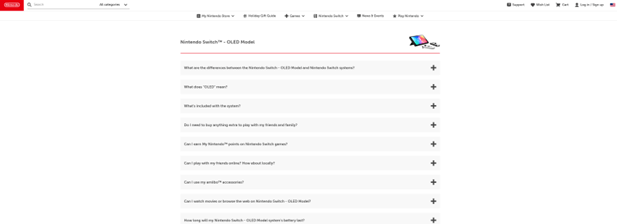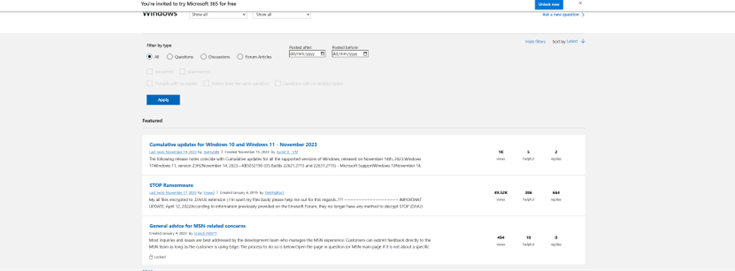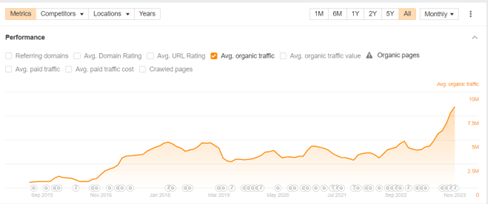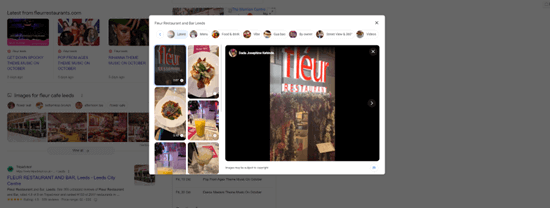How user-generated content improves SEO
When it comes to content creation, we all know the importance of producing high-quality and informative content, but it’s important we don’t forget the value of what users can do for your content strategy.
A recent Stackla survey found that user-generated content influenced people’s purchasing decisions. Furthermore, user-generated content could be the main driving force of sales and leads depending on your industry.
In this article, we’ll explore what user-generated content (UGC) is, the different types, the importance, and nine examples that help drive your brand and SEO growth.
What is user-generated content?
User-generated content, often known as UGC or consumer-generated content, refers to any content, such as text, images, videos, reviews, or other media forms, created and shared by users or consumers rather than by a brand, company, or professional content creator.
UGC is typically produced by individuals who are not necessarily paid for their contributions but voluntarily share their thoughts, experiences, or creative works on various online platforms or social media.
Different types of user-generated content
A wide variety of user-generated content is available across various online platforms. Some common types of user-generated content include:
- Video content: With TikTok emerging as one of the fastest-growing social media platforms, it has become a popular space for user-generated content for shopping and product experiences. Users often create videos showcasing product usage, packaging reviews, or include products in their daily routines.
- Images: Images are a common form of user-generated content. These can include pictures of your product, before-and-after results, or any visual content that users create and share.
- Community forums: Online forums are a hub for discussing various products and brands. Users share their experiences, both positive and negative, and engage in conversations about products and services.
- Reviews: Online reviews play a significant role in consumer decision-making, with 90% of consumers saying online reviews affect shopping choices. Regardless of your business’s size, reviews are a vital aspect of user-generated content that can strongly impact your brand’s success.
The importance of user-generated content
Authenticity holds immense significance, and UGC is pivotal in establishing trust for businesses and online communities. Research highlights that 90% of consumers prioritize authenticity when selecting brands to support. UGC serves as a cornerstone of this authenticity for several reasons.
UGC is often perceived as more genuine and reliable than brand-generated content. This mirrors users’ honest opinions, experiences, and creativity, cultivating trust and credibility. UGC enhances user engagement on websites and social media platforms, creating a vibrant sense of community and active participation.
Alongside this, UGC carries the potential for SEO benefits through diverse user-generated keywords and engaging content, all while serving as a cost-effective marketing tool, with satisfied customers willingly sharing their experiences to promote the brand without added advertising expenses effectively.
How is user-generated content used on websites?
You might notice that your brand has gained significant user-generated content across social media platforms and third-party websites.
However, the question remains: how can you effectively leverage this valuable content on your website to enhance your SEO strategy? Let’s delve into the details and uncover the user-generated content ideas that will support you to do just that.
Landing pages dedicated to UGC
In certain instances, websites incorporate dedicated landing pages designed exclusively for user-generated content. Some common examples of such pages include:
● Shoppable feed pages
● Review pages
● Gallery pages
● Community blogs
These pages offer a valuable opportunity for implementing internal links and conveying a strong sense of authenticity associated with your brand. These pages often contain entirely embedded content, such as social media integrations.
This practice can have significant benefits, as it provides social signals to search engines, signifying active user engagement and enhancing brand visibility on social media platforms.
In addition to these SEO benefits, user-generated content builds trust and credibility. For instance, a page filled with user reviews and testimonials establishes a sense of authority that search engines take note of. This, in turn, boosts your brand’s credibility and offers support to users as they navigate their buying journey.
UGC embedded throughout pages
User-generated content is often integrated into websites instead of being housed on dedicated pages. Leveraging UGC provides significant advantages to businesses and enhances purchasing experiences.
For example, let’s take an e-commerce website with an extensive product catalog. One effective strategy is to incorporate user reviews directly onto each product page.
This approach serves a dual purpose: it establishes authority and credibility in the eyes of both users and search engines. Many websites have successfully employed this tactic by seamlessly integrating reviews from platforms like Google and Trustpilot throughout their various pages.
User recommendations
Templates have emerged as a common form of user-generated content in numerous industries. For instance, multiple SaaS (Software as a Service) companies provide products that enable users to personalize and craft templates from the ground up. These templates, in turn, offer valuable assistance to other users in gaining maximum benefits from the product.
Template creation is widespread in industries like design, data management, project coordination, and development. The practice catalyzes collaborative engagement among users, fostering a dynamic exchange of knowledge about your product or service through insights shared by those presently utilizing it.
Community portals
Community portals are a frequent feature on websites, and in some cases, they are hosted on subdomains. These portals often serve as a hub for user support, allowing users to discuss features or troubleshoot issues they may encounter.
However, they can also serve as platforms for users to express their appreciation for noteworthy features and engage in positive discussions. Such community engagement is advantageous for your website, enhancing the overall user experience and offering valuable support when help queries appear in search engine results pages (SERPs).
Content influenced by UGC
Even if you choose not to incorporate the source of user-generated content onto your website directly, it can still serve as a valuable resource for generating content that aligns with your readers’ search queries.
For example, by observing discussions on social media, community forums, or platforms like Google Business, where people ask specific questions about your business, you have the perfect opportunity to craft content that addresses these inquiries.
Why not leverage this user-generated content to inform the development of frequently asked questions (FAQs) on your website? This approach allows you to tap into the insights gained from these discussions, ultimately enhancing your support to your audience as they make informed purchasing decisions.
Who creates user-generated content?
User-generated content is created from a variety of individuals, including:
● Customers: Customers frequently generate content through product reviews, testimonials, and multimedia like photos and videos, sharing their experiences with a brand’s offerings.
● Social media users: Those who follow or engage with your brand on social platforms contribute UGC, comprising posts, tweets, images, and videos. Brands often incentivize users to use specific hashtags or join challenges to generate such content.
● Enthusiasts: Individuals passionate about specific hobbies, interests, or niches may create content around your products or services. For instance, car enthusiasts might produce content about their favorite car brands.
● Employee advocacy: Employees can serve as brand advocates by sharing their positive work experiences and expertise on social media, promoting the company and its positive work culture while providing valuable content in various forms like blog posts, webinars, and whitepapers.
9 user-generated content examples to support your SEO
Let’s explore 9 UGC examples that can significantly bolster your SEO efforts and drive organic growth for your website.
1. Reviews, testimonials & success stories
Reviews, testimonials, and success stories are excellent forms of UGC that benefit SEO. They offer valuable, real-world insights that build trust and credibility with potential customers.
Positive reviews can improve click-through rates and increase users’ time on your site. Additionally, user-generated keywords found in these content types enhance the diversity of search terms associated with your brand, potentially attracting more organic traffic.
When properly optimized and moderated, reviews and testimonials can significantly enhance your website’s authority, resulting in higher search engine rankings and better online visibility.
Bizzabo has an entire page dedicated to customer success stories, including reviews, case studies, and testimonials.

Another great example is from Codecademy, which shows customer success stories in more of a blog format, showing the impact on individual lives using its products and services.

2. Strategic on-page
Strategic on-page UGC offers several benefits. As an example, let’s look at Oodie’s use of user images and reviews on product pages. Firstly, it enhances the overall user experience by providing real, relatable insights from customers who have experienced the product. These reviews and images serve as valuable social proof, building trust and credibility with potential buyers

From an SEO perspective, they contribute to content freshness, diversity of keywords, and longer on-page engagement, all of which positively impact search rankings. Additionally, UGC on product pages often results in higher conversion rates, as 93% of customers will read online reviews before making a purchase, ultimately increasing sales and brand loyalty.
3. FAQs
FAQs (Frequently Asked Questions) on websites are often influenced by user-generated content, reflecting common inquiries and concerns from the user community.
For instance, the Nintendo Switch FAQ page could be incorporating UGC-influenced questions based on user experiences and issues. Users might inquire about compatibility with specific games, troubleshooting tips for common problems, or recommendations for accessories.

By addressing these UGC-influenced FAQs, Nintendo can enhance user support, reduce customer service inquiries, and foster a sense of community, ultimately improving the overall user experience on its website and product.
4. Shopping feed pages
Instagram gallery pages on websites, such as the My Fabletics page, offer a powerful form of UGC. By curating user photos with a branded hashtag, it showcases authentic, real-world product experiences and customer satisfaction.

This fosters a sense of community and trust around the brand. By linking these UGC images to the corresponding Fabletics products, the website provides potential customers with visual proof of the product’s desirability and enhances SEO by increasing content relevance and engagement. It encourages users to stay on the website, interact with the brand, and potentially lead to more conversions, all contributing positively to organic search engine performance.
5. Comments and discussions
Forums and community discussion pages, such as Microsoft Community, are valuable forms of user-generated content that benefit user experience and SEO. Microsoft Community, for instance, allows users to ask questions, share knowledge, and seek help related to Microsoft products. These platforms create a sense of community and offer a space for users to find solutions to their problems.

This enhanced user experience fosters trust and brand loyalty. These discussion pages are rich in user-generated keywords, long-tail phrases, and topic relevance.
By providing a platform for users to interact, ask questions, and share insights, these forums not only contribute to a robust user experience but offer fresh and relevant content that search engines value.
The Microsoft Community subdomain has approximately 8.9 million monthly sessions and targets 3.6 million keywords, stands as a substantial example. This impressive case is a testament to the remarkable impact that nurturing a sense of community and UGC has on your business.

6. User-submitted photos and videos
User-submitted photos and videos are valuable forms of UGC because they provide visual, authentic, and relatable content that resonates with users.
These elements are essential ranking factors for search engines. Additionally, visual content often encourages social sharing and backlinks, improving your website’s authority and online visibility.
When users create and share images or videos related to your products or services, it showcases real-world usage and builds trust, helping to improve conversions and search engine rankings simultaneously.
7. User-generated templates and guides
User-generated templates and guides are valuable forms of UGC as they offer practical, real-world solutions for specific tasks or topics. These resources can help other users save time and effort, making them more likely to engage with and trust your website.
Additionally, they often incorporate long-tail keywords and relevant content aligning with users’ search queries, enhancing SEO. User-generated templates and guides can foster a sense of community and demonstrate expertise, further building credibility and authority for your brand or platform.
8. Social media
Social media and user-generated content are instrumental for brand success and capable of propelling brands to new heights. Take We Are Wild, for instance, a sustainable deodorant company that partners with influencers to amplify their message.
By running campaigns like “Wilf-ify your life” and reposting content from brand advocates, they harness the power of UGC to build a loyal community and increase their brand visibility.

Likewise, Wild and Wood skincare thrives by integrating UGC into its brand narrative. Founders and employees share behind-the-scenes content, providing transparency and authenticity.
Customer “before and after” photos and reviews merge seamlessly with brand content, fostering trust and showcasing real-life product benefits. In both cases, social media and UGC serve as catalysts, facilitating brand recognition and success.

9. Google Business Profiles
Google Business Profiles show UGC through features such as Q&A sections and user-uploaded images. Fleur Cafe, for instance, benefits from customers asking questions about its offerings, which it promptly answers, enhancing transparency and credibility. UGC images showcasing the cafe’s aesthetics provide a visual enticement for potential customers.

This not only improves the brand image by offering a glimpse into the cafe’s ambiance but also drives traffic to Fleur Cafe’s website. Users intrigued by the UGC images are more likely to visit the cafe’s site for more information and potentially make reservations or place orders.
Tips for using user-generated content
We’ve put together some valuable tips to effectively use UGC, whether you’re looking to boost your marketing efforts, enhance your online presence, or build a loyal and engaged community around your products or services.
Clearly define guidelines
Clearly defining guidelines for UGC is vital for maintaining content quality, relevance, and safety on your platform or website.
Guidelines help control content quality, enforce safety and legality standards, maintain brand consistency, and provide clarity to contributors. They prevent spam, support efficient moderation, ensure legal compliance, and foster user trust and positive community culture.
Well-communicated guidelines play a key role in shaping UGC’s quality, relevance, and integrity while promoting a safe and engaging online environment.
Permission is crucial
Permission is crucial for using UGC because it ensures legal and ethical use of content created by individuals. Obtaining explicit consent from content creators safeguards against copyright infringement, privacy violations, and potential legal disputes.
It respects the rights of the content owners, maintains trust with users, and upholds ethical standards. Permission also allows brands and organizations to leverage UGC confidently, knowing they have the legal right to utilize and showcase the content for marketing, promotional, or informational purposes while respecting the creators’ rights and intentions.
Don’t forget about the original creator
Crediting the original poster/creator in UGC, even if they don’t request it. It shows respect for the individual’s creative work and intellectual property rights, demonstrating a commitment to fair and honest content usage.
Giving credit enhances the authenticity of the UGC and reinforces trust with your audience, as they can see the source of the content. This practice not only upholds a high standard of integrity but also builds positive relationships with content contributors, fostering a culture of respect and collaboration within your community.
Strategy is key
A strategy is crucial for UGC because it helps organizations plan, guide, and maximize the impact of UGC efforts. A well-defined UGC strategy sets clear goals, identifies target audiences, outlines content guidelines, and establishes a framework for collecting, moderating, and promoting UGC.
It ensures consistency, brand alignment, and a focus on content that resonates with the audience. A UGC strategy also helps manage potential risks, such as inappropriate or harmful content, and allows for the effective integration of UGC across various marketing channels.
In essence, a UGC strategy is the roadmap for leveraging the authenticity and engagement that UGC can offer to benefit a brand or business.
Quality control
Quality control is essential for UGC to maintain credibility and trust. Ensuring the accuracy, relevance, and appropriateness of UGC is vital to present a positive image of your brand or platform.
Effective quality control filters out low-quality, spam, or inappropriate content, enhancing the user experience and preventing reputational damage. By setting clear guidelines, moderating submissions, and actively curating content, you can maintain a high standard of UGC that benefits both users and your brand.
Engage with users
Engaging with users is crucial for UGC because it fosters community, trust, and brand loyalty. Interactions demonstrate that you value and appreciate user contributions, encouraging more UGC.
Engaging also allows you to address concerns, clarify doubts, and provide a personalized touch to customer service. Users who feel heard and acknowledged are more likely to become loyal customers, advocates, and long-term community members, ultimately benefiting your brand’s reputation and credibility.
Measure and analyze
Measuring and analyzing UGC is crucial because it provides valuable insights into its impact, effectiveness, and user engagement.
By assessing metrics like user interactions, conversion rates, and the sentiment of UGC, businesses can gauge the success of their UGC strategies, identify trends, and make data-driven decisions to optimize their content and engagement efforts.
This analysis allows companies to enhance the user experience, build trust, and create more relevant and appealing content, ultimately leading to improved brand loyalty, higher conversions, and better overall performance in the digital landscape.
Closing thoughts
Incorporating UGC into your SEO strategy is a dynamic and rewarding approach to enhance your digital presence. The ideas explored in this section demonstrate the versatility and impact of UGC, from review pages and social feeds to forums and employee advocacy.
By actively encouraging and curating UGC, you can engage your audience, improve authenticity, and strengthen your brand’s online footprint. These UGC-driven SEO strategies are not only effective in boosting your search engine rankings but also in building trust and lasting connections with your target audience.
As you implement these ideas, remember to commit to quality, relevance, and user satisfaction, ultimately positioning your brand for sustainable SEO growth.